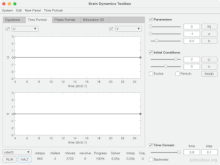Van der Pol oscillator
In the study of


History
The Van der Pol oscillator was originally proposed by the Dutch
The Van der Pol equation has a long history of being used in both the
Two-dimensional form
- .
Another commonly used form based on the transformation leads to:
- .
Results for the unforced oscillator
- When μ = 0, i.e. there is no damping function, the equation becomesThis is a form of the simple harmonic oscillator, and there is always conservation of energy.
- When μ > 0, all initial conditions converge to a globally unique limit cycle. Near the origin the system is unstable, and far from the origin, the system is damped.
- The Van der Pol oscillator does not have an exact, analytic solution.Lienard equationis a constant piece-wise function.
- The period at small μ has serial expansion See Poincaré–Lindstedt method for a derivation to order 2. See chapter 10 of [14] for a derivation up to order 3, and [15] for a numerical derivation up to order 164.
- For large μ, the behavior of the oscillator has a slow buildup, fast release cycle (a cycle of building up the tension and releasing the tension, thus a relaxation oscillation). This is most easily seen in the form In this form, the oscillator completes one cycle as follows:
- Slowly ascending the right branch of the cubic curve from (2, –2/3) to (1, 2/3).
- Rapidly moving to the left branch of the cubic curve, from (1, 2/3) to (–2, 2/3).
- Repeat the two steps on the left branch.
- The leading term in the period of the cycle is due to the slow ascending and descending, which can be computed as:Higher orders of the period of the cycle iswhere α ≈ 2.338 is the smallest root of Ai(–α) = 0, where Ai is the Airy function.(Section 9.7 [16]) ([17] contains a derivation, but has a misprint of 3α to 2α.)
- The amplitude of the cycle is [18]
Hopf bifurcation
As μ moves from less than zero to more than zero, the spiral sink at origin becomes a spiral source, and a limit cycle appears "out of the blue" with radius two. This is because the transition is not generic: when ε = 0, both the differential equation becomes linear, and the origin becomes a circular node.
Knowing that in a Hopf bifurcation, the limit cycle should have size we may attempt to convert this to a Hopf bifurcation by using the change of variables which gives
Hamiltonian for Van der Pol oscillator

One can also write a time-independent Hamiltonian formalism for the Van der Pol oscillator by augmenting it to a four-dimensional autonomous dynamical system using an auxiliary second-order nonlinear differential equation as follows:
Note that the dynamics of the original Van der Pol oscillator is not affected due to the one-way coupling between the time-evolutions of x and y variables. A Hamiltonian H for this system of equations can be shown to be[20]
where and are the conjugate momenta corresponding to x and y, respectively. This may, in principle, lead to quantization of the Van der Pol oscillator. Such a Hamiltonian also connects[21] the geometric phase of the limit cycle system having time dependent parameters with the Hannay angle of the corresponding Hamiltonian system.
Quantum oscillator
The quantum van der Pol oscillator, which is the
Forced Van der Pol oscillator

The forced, or driven, Van der Pol oscillator takes the 'original' function and adds a driving function Asin(ωt) to give a differential equation of the form:
where A is the
.Popular culture
Author
See also
- Mary Cartwright, British mathematician, one of the first to study the theory of deterministic chaos, particularly as applied to this oscillator.[28]
References
- ^ Heitmann, S., Breakspear, M (2017-2022) Brain Dynamics Toolbox. bdtoolbox.org doi.org/10.5281/zenodo.5625923
- ISSN 0024-6107.
- ^ B. van der Pol: "A theory of the amplitude of free and forced triode vibrations", Radio Review (later Wireless World) 1 701–710 (1920)
- ISSN 1941-5982.
- S2CID 186244992.
- ^ Kanamaru, T., "Van der Pol oscillator", Scholarpedia, 2(1), 2202, (2007).
- PMID 19431309.
- S2CID 51648050.
- S2CID 9120223.
- ISSN 1939-800X.
- ^ Kaplan, D. and Glass, L., Understanding Nonlinear Dynamics, Springer, 240–244, (1995).
- ISBN 0-8493-8607-1.
- S2CID 120504403.
- ISBN 978-3-540-60934-6.
- ISSN 0036-1399.
- )
- OCLC 28275539.
- ISSN 1385-7258.
- OCLC 1112373147.)
{{cite book}}: CS1 maint: location missing publisher (link - S2CID 14930486.
- S2CID 51635019.
- ^ S2CID 224801468.
- S2CID 7950471.
- S2CID 33622111.
- ISBN 0719018110, pp. 213–214.
- ISBN 0-14-009250-1.
- ^ Colman, David (11 July 2011). "There's No Quiet Without Noise". New York Times. Retrieved 11 July 2011.
- ISSN 0024-6107.


























